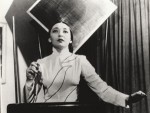Title
I first met Clara Rockmore when I was a very young girl, during one of my frequent visits to her sister, the brilliant pianist Nadia Reisenberg, who was on the Juilliard faculty from 1975 until her death in 1983. Nadia (whose son Robert Sherman is currently on the Juilliard faculty) was a significant mentor during my early musical development as a pianist and composer. From my first afternoon visit to Clara’s 57th Street apartment for tea when I was 9 years old, I was intensely drawn to the curious black box standing elegantly in her living room, resembling a quaintly designed lectern (if one were to ignore the two antennae) or antique radio. It was a theremin, one of the first electronic musical instruments, built in 1927 by the Russian inventor and amateur cellist Lev Termen.
Body
The theremin is unique in that it is played without physical contact. The performer stands in front of the instrument moving her hands midair within the proximity of two metal antennae—one of which controls frequency, the other amplitude—in order to manipulate pitch and volume. The distance between player and pitch antenna is akin to an imaginary and ever-shifting fingerboard, especially sensitive to environmental factors such as vibration, humidity, and movement.
Clara Reisenberg Rockmore was born in Russia on March 9, 1911. Starting as a violin prodigy, she studied with Leopold Auer alongside older students Jascha Heifetz and Nathan Milstein. Some years after immigrating to the United States and enrolling at the Curtis Institute of Music, Clara was tragically afflicted by tendinitis in her bow arm, and was obliged to give up the violin. After meeting Lev Termen and discovering a facility and predilection for his new invention, the theremin (then also known as the aetherphone or the termenvox), Clara became his muse, performing widely and collaborating with him to refine the instrument. She became the foremost ambassador for the theremin, applying her profound musicality toward its performance and developing a technique based on the principle of aerial fingering that has been unequalled to this day. It is possible that Clara’s one-of-a-kind technique and searing musical voice were due in no small part to her need to sublimate her violinist’s instincts and tendencies into her theremin performance. Seemingly from out of the ether, she could carve phrases of such lyricism and delicacy that one might even detect the subtleties of bowing in her playing.
When I first heard Clara’s playing, her instrument’s incomparable tone suggested a sonic mélange of violin and voice merged with the otherworldly, awakening within me a deep sadness and sense of eerie fantasy. My affinity for the instrument and my absolute pitch (a desirable trait when dealing with a fluctuating fingerboard!) led Clara to have high hopes for me as a thereminist. In 1991, when I was 16, she began teaching me in earnest, creating a book of technical studies and assigning me such Romantic solo string works as Dvorak’s Humoresque, Bach’s “Air on the G String” and Saint-Saëns’s The Swan (now a theremin standard). Also a serious pianist at the time, I was advancing on the theremin until tendinitis (and some theremin elbow) prevented me from continuing my studies, either on theremin or on piano. When Clara died, in 1998, I resolved to realize her vision of the theremin’s admittance onto the roster of serious classical instruments, by creating for it a repertoire that would reveal its hidden expressive potential, aside from more obvious novelty effects such as large multiple-octave glissandi, heavy vibrato, and capacity for dynamic extremes.
In my new CD, Dalit Warshaw: Invocations (Albany Records/Troy 1238), I reconcile three different aspects of my musical identity, as composer, pianist, and thereminist. Aside from featuring a spectrum of my recent works for solo cello, piano, string quartet, voice, and theremin, the recording is a tribute to Clara, whose centennial takes place on March 9, 2011. The theremin appears in two works: Transformation for theremin and string quartet andNizk’orah (written for Clara in memoriam) for two theremins and piano. In the latter, I performed and then overdubbed all of the parts, playing on two theremins: Clara Rockmore’s as well as Bob Moog’s 91W, the replica of Clara’s theremin that he built for me in 1991. In doing so, a rare dialogue was enabled between these two one-of-a-kind theremin “siblings.” By playing the piano in addition to both theremin parts, I sought to pay homage not only to Clara but also to her sister Nadia Reisenberg, who was her main accompanist during performances and recordings.
As a composer with a propensity for orchestral writing, I have sometimes likened my connection to the orchestra to Clara’s relationship with her theremin. As a pianist who has often been chagrined by the ephemeral and imperfect nature of live performance, I regard composition as my chance to capture perfection, codifying my musical intentions by chiseling all interpretative intent into the score. For me, the most exciting scenario is to enable an ensemble of 100-some musicians to sound intimate and organic, to create a personal voice out of something fundamentally impersonal. Clara, similarly, used an electronic apparatus to achieve an intensely human voice, bestowing a soul to the nonhuman. This paradox lends an enigmatic layer of tension to the captivating, vital, and haunting intensity of her playing.





